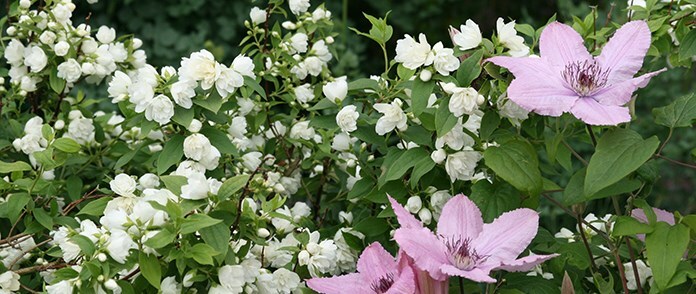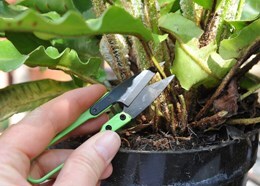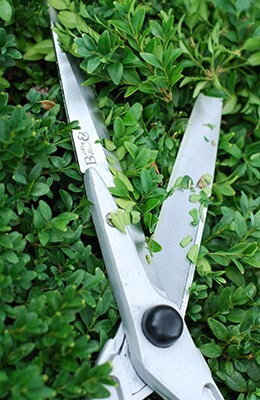Summer Shrub Pruning
There are many shrubs that can be pruned from now until the end of the summer, so this is an ideal time to plan what you are going to do. Most don’t need routine pruning, but a little judicious cutting back will help improve displays and prevent them getting out of control. Deadheading and removing frost-damaged shoots can also be tackled at this time of the year. So, if your shrubs are looking a bit tired and threadbare, here are a few tips that will help.

Early-flowering shrubs Well-established, deciduous shrubs that have just finished flowering, such as flowering currant, forsythia and early spiraeas as well as shrubs coming to the end of their blooming season, such as mock orange (philadelphus) and deutzia can be pruned during early summer. They will readily produce new shoots from the base and if pruned immediately after flowering. Using a pair of secateurs or loppers, remove any dead, diseased or damaged stems. Then aim is to remove one-third of the main stems, starting with the oldest, cutting just above ground level. This will encourage new flowering shoots and help reinvigorate the plant.
 Annual light trim Some shrubs won’t produce new shoots from the base if cut back hard, so need to be given a short-back-and-sides each year to keep them in shape. This should be done immediately after flowering. Shearing off the dead flowers and shoot tips of heathers and lavender, for example, will help keep them looking tidy and encourage compact growth. Other shrubs that respond to a light annual trim include broom, genista and sun rose. Now that the spring rush of growth is over, it’s also an ideal time to give topiary a trim to redefine its outline.
Annual light trim Some shrubs won’t produce new shoots from the base if cut back hard, so need to be given a short-back-and-sides each year to keep them in shape. This should be done immediately after flowering. Shearing off the dead flowers and shoot tips of heathers and lavender, for example, will help keep them looking tidy and encourage compact growth. Other shrubs that respond to a light annual trim include broom, genista and sun rose. Now that the spring rush of growth is over, it’s also an ideal time to give topiary a trim to redefine its outline.
Topiary with a difference Cloud-pruned small-leaved evergreens, such as box, have become the height of gardening fashion in recent years. This pruning technique is based on an ancient Japanese method of trimming and training evergreens into cloud-like formations. Despite appearing rather intricate and complicated, cloud-pruning is actually very easy to do…provided you have the patience. And June is an ideal time to get started. Choose a compact-growing shrub with interesting framework of branches that will look attractive when exposed. Then simply trim away the foliage part-way down the shrub to reveal the stem and clip the end growth to form cloud-like formations. Here’s one I did earlier
 Pruning out problems It is worth spending time to look at all your shrubs to check for problems. Winter damage will be very evident now and should be pruned out. If you are removing a large stem, you may have to trim the rest of the shrub to rebalance its shape. A few grafted shrubs, such as lilacs and roses, are prone to suckering from the rootstock. These vigorous new shoots will not be the ornamental variety and need to be removed. Do this by excavating a hole to trace the sucker back to its point of origin and then rip it clean off. This may sound brutal, but it is the only way to be sure it won’t regrow. Also, be on the lookout for more vigorous plain-green shoots on variegated shrubs. These ‘reverted’ shoots need to be removed otherwise they will out-grow and swamp the variegated growth. Again, trace the rogue shoot back to its origin and remove it entirely, this time using secateurs - making a clean cut back into variegated growth.
Pruning out problems It is worth spending time to look at all your shrubs to check for problems. Winter damage will be very evident now and should be pruned out. If you are removing a large stem, you may have to trim the rest of the shrub to rebalance its shape. A few grafted shrubs, such as lilacs and roses, are prone to suckering from the rootstock. These vigorous new shoots will not be the ornamental variety and need to be removed. Do this by excavating a hole to trace the sucker back to its point of origin and then rip it clean off. This may sound brutal, but it is the only way to be sure it won’t regrow. Also, be on the lookout for more vigorous plain-green shoots on variegated shrubs. These ‘reverted’ shoots need to be removed otherwise they will out-grow and swamp the variegated growth. Again, trace the rogue shoot back to its origin and remove it entirely, this time using secateurs - making a clean cut back into variegated growth.
